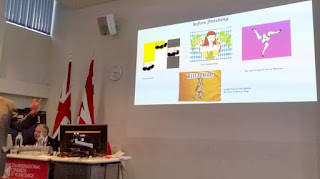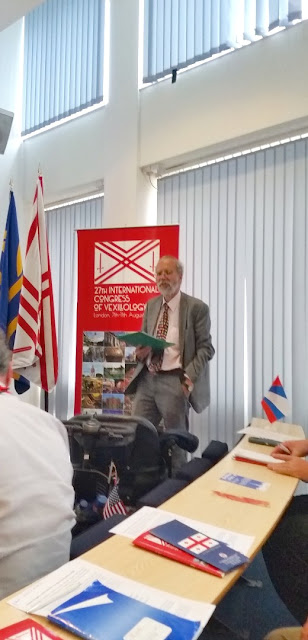Translate
Thursday, August 10, 2017
ICV 27 - Speaker 30: Stan Zamyatin
Zamyatin spoke about the various county flags in Ireland with his paper County Flags of Ireland. Zamyatin noted that county colours are often more important than the heraldic icons are symbols upon the various flags.
Stan also noted that the Yew Tree is an ancient symbol of Ireland, which better represents the Emerald Isle rather than the official Oak Tree which can be confused the Oak of England. Zamyatin pointed out that colours often have a tribal essence that go deeper than the design. This was demonstrated with sporting flags wearing colours like tribesmen yet being of different nations.
Zamyatin ended his presetation with a colour act by wearing flag of Portugal with a headband.
Stan also noted that the Yew Tree is an ancient symbol of Ireland, which better represents the Emerald Isle rather than the official Oak Tree which can be confused the Oak of England. Zamyatin pointed out that colours often have a tribal essence that go deeper than the design. This was demonstrated with sporting flags wearing colours like tribesmen yet being of different nations.
Zamyatin ended his presetation with a colour act by wearing flag of Portugal with a headband.
ICV 27 - Speaker 29: Uros Zizmund
Two flags and proposals for Slovenia were presented with his paper Two Flags, Two Proposals: a New System of National and Rank Flags of Slovenia. Typically one flag is proposed to replace an existing flag, but Zizmund presented two flags for Slovenia. The need for a new flag has arisen since the Slovenian flag looks like the Slovak and Russian flags.
 In addition to the new designs, applications for the military and rank flags were proposed in succession to the newly proposed flags.
In addition to the new designs, applications for the military and rank flags were proposed in succession to the newly proposed flags.Could we be looking at the future flag of Slovenia? Only time will tell.
ICV 27 - Speaker 28: Patrice de La Condamine
The subject of women and flags were presented in his paper entitled Flags and the Woman. Condamine focused on portrayal of women on flags. They can be seem of patriotic or rather "matriotic" heroines, religiously, warriors, motherly images, and many other ways.
He noted that although Islamic statues forbids the portrayal of women in forms, one flag in Egypt has the statue bust of Nefertiti upon it. Caondmine also pointed out several flags from Nazi Germany and North Korea that used women to inspire and represent the people.
 Patrice also pointed out some fun flags, which included the proverbial tri-skelleton flag for the opposing gender the Isle of Woman.
Patrice also pointed out some fun flags, which included the proverbial tri-skelleton flag for the opposing gender the Isle of Woman.
ICV 27 - Speaker 27: Avelino Couceiro Rodriguez
The flags were discussed about the origins of Puerto Rico and Cubs. Although Rodriguez was not able to present his paper, in his steed the program coordinator Ian Sumner was able to give a fascinating summary of Avelino's work.
These flags have their origins in by dictation from a person who was Venezuelan. Since many Spanish Colonies were fighting against Spain there was a common sentiment of brotherhood. However the Spanish Colonies never reached the maximums as they did in the United States or Canada.
Another interesting point was the effect of Fosfenia, in the creation of the these flags. Fosfenia happens when the after image is retained after one closes ones eyes. This is easily noticed when one still sees the flash from a camera or when one looks at a bright light.
These flags have their origins in by dictation from a person who was Venezuelan. Since many Spanish Colonies were fighting against Spain there was a common sentiment of brotherhood. However the Spanish Colonies never reached the maximums as they did in the United States or Canada.
Another interesting point was the effect of Fosfenia, in the creation of the these flags. Fosfenia happens when the after image is retained after one closes ones eyes. This is easily noticed when one still sees the flash from a camera or when one looks at a bright light.
ICV 27 - Speaker 26: Ales Brozek

Brozek spoke flags in rowing clubs in the Czech. Brozek's paper was entitled The Survey of Flags Used by Rowing Clubs in the Czech Republic.
Brozek presented an overview of the flags used by rowing clubs. Interestingly he showed up flags of rowing clubs for the blind.
It was a colourful display in interesting and unique flags.
ICV 27 - Speaker 25: David Chkheidze
We saw an overview of municipal flags about the nation of Georgia. Chkeidze's paper was entitled The Flags of Contemporary Georgia.
Chkheidze noted that the Republic of Georgia's post Soviet flag is an ancient design dated back to Pre-Columbian times. Georgia's flag is essentially a heraldic flag. Currently there are 66 districts and 12 self governing cities in the Republic of Georgia. Chkeidze gave a delightful overview of Georgia's modern day flags that incorporate good design linked to real geographic elements. He also noted that the Republic of Georgia has many local ethnic groups. Even the touchy subject of the break away territories were included: Abkhazia and Adjara.
 |
| Origin of Republic of Georgia's Flag 1367 |
He said the hardest part about making flags was that people sometimes want to include too much: every historical symbol and icon, making the flags virtual tourist guide maps, which results in very 'ugly' flags.
Subscribe to:
Posts (Atom)





